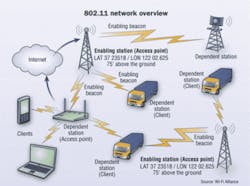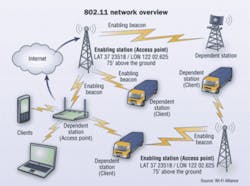Essentials of an 802.11y network
The recently approved standard will allow for high-powered Wi-Fi-enabled communications at distances of 3 miles or more.
In late September of last year, the IEEE (www.ieee.org) approved for publication the 802.11y wireless standard, enabling high-powered Wi-Fi equipment to operate in and "cooperative use" of the mostly vacant 3650 to 3700 MHz band. In essence, the amendment to the 802.11-2007 standard, in conjunction with the FCC's (www.fcc.gov) 3650 MHz Order established in 2005, allows for increased wireless operation for more users at a much higher power than via traditional Wi-Fi equipment—up to 3 miles or more—and, according to the FCC will "create a spectrum environment that will encourage multiple entrants and stimulate the expansion of broadband service," especially in rural areas.
The Wi-Fi Alliance (www.wi-fi.org), a non-profit industry association of more than 300 member companies devoted to promoting the growth of WLANs, recently published a discussion paper on the 802.11y standard, "A New Regulatory and Technical Environment for Wireless Broadband." In its report, the Alliance notes that the key intentions of the FCC order include "to lower the cost of entry and compliance while allowing market forces to derive maximum value from the available spectrum through shared use."
The Order requires robust coexistence capabilities, and the Alliance says that "Wi-Fi technology is especially well suited to meet the requirements for avoiding interference…Because the contention-based protocol used by Wi-Fi technology senses and responds to a broad range of potential technologies, 100% of the 3650 MHz band is available to networks using the 802.11y protocol."
The 3650 MHz band has been largely vacant due to the range limitations of radio waves and intentional frequency spacing to avoid interference, but the Alliance report notes, "The expectation is that successful deployment of [the Wi-Fi] model in the 3650 MHz band can and should lead to a much broader allocation of spectrum for lightly licensed networks utilizing a contention-based protocol mechanism—eventually including most of the knownunused or underused radio spectrum."
Light licensing means that licensees pay a small fee for anationwide, non-exclusive license, and then pay an additional nominal fee for each deployed high-powered base station.
Potential installations include industrial automation and control, campus and enterprise networks, and public safety and security networks. In one scenario of a potential 802.11yinstallation, a fire station locates an enabling station (see description below) on its communications tower, and uses dependent stations on each fire truck and laptop. The incident commander controls the enabling station using a Public Safety band radio.
Wi-Fi Alliance discussion paper excerpt
Through the courtesy of the Alliance, the following excerpts from their white paper describe the major elements and operation overview of an 802.11y network:
• Enabling stations. An enabling station is a high-powered fixed station with authority to control when and how adependent station can operate. An enabling station communicates an initial enabling signal to its dependents over the air. The enabling station may then direct supporting enablement messages to be exchanged over the air, over another dependent station, or by mechanisms that rely on transport via higher layers. As with all high-powered stations, GPS coordinates and altitude information of enabling stations are registered in a public database to enable stations experiencing interference to locate interfering stations and seek interference mitigation. Enabling stations must include location information in every beacon.
• Dependent stations. Dependent stations are devices in the network that are not registered, but instead receive authorization to transmit from a registered enabling station over the air. Failure to receive the enabling beacon at regular, defined intervals requires a dependent station to suspend transmission until it is re-enabled. A dependent station may be fixed or mobile.
• Regulatory class information. Each device in a network must be able to operate within regulatory requirements of any channel available to it. Prior to 802.11y, channel switching only occurred within a particular band, where only transmit power limits may have changed. Future implementations will be able to move outside of the original band, complying with the regulatory requirements specified by the regula-tory class octet in every beacon.
Together, these new elements support three significant new mechanisms defined in 802.11y:
• Dynamic Station Enablement (DSE). [This is] the process by which an enabling station grants permission and dictates operational procedures to dependent stations. The lightly-licensed structure of the FCC regulations for 3650 MHz calls for the creation of procedures to govern the use of the band and treatment of violations. DSE supports the lightly-licensed regulatory model by empowering the network operator to ensure appropriate operation of base stations and the dependent stations they enable. Beyond addressing the regulatory requirements for the 3650 MHz Order, DSEoffers the promise of other channel management and coordination benefits.1 For example, since the enabling station is not required to serve as the access point for each of its dependent stations, DSE can reduce the likelihood of a dependent station contributing to radio interference by allowing the dependent station to complete the enablement process via a geographically closer access point and ultimately through a channel other than the air (e.g., the Internet).1
• Contention-based protocol incorporating regulatory class information. 802.11y devices can sense both 802.11 and non-802.11 devices and identify available spectrum as small as 5MHz. 802.11y access point beacons identify the country and the regulatory domain for their physical location. By incorporating both channel use and regulatory class information, 802.11y devices can identify available channels and adjust operating parameters to the laws of the country in which the access point resides.
• Extended Channel Switch Announcement (ECSA). A methodology to coordinate a move from one channel to another with less contention or to change channel bandwidth.1 Specifically, an enabling station can identify the channel with the least aggregate interference to all of the stations that are connected to it on a completely dynamic basis. This capability ensures the best signal-to-noise ratio and lowest power levels possible. ECSA also incorporates regulatory class information—if a channel switch moves the network to a new regulatory domain, the station shifts to the approved frequencies and channels for the new domain. ECSA originates in 802.11y, and is now being applied retroactively to 802.11n and the other proposed concepts across 802.11.
Network operation overview
The first requirement for establishing an IEEE 802.11y network is determining if the area to be covered is in an exclusion zone. If it is outside of the protected regions, the network operator must file for a license, pay a small fee, and register the location of the enabling station in a public database. Dependent stations, fixed and mobile, may then be added to the network based on their ability to receive and decode the enabling beacon. Once enabled, each dependent station continually tests its ability to receive and decode an enabling beacon. Failing this test, the dependent station attempts to reacquire the beacon, with a finite number of attempts before ceasing trying for a predetermined amount of time.
This requirement prevents congestion caused by stations that may be truly out of range of an enabling beacon. Enabling stations continually test for interference. If interference is detected, the enabling station must silence the network and search for a clear channel. When a new channel is identified, ECSA directs all of the devices in the network to move to the new channel, which may include a change in regulatory class, as specified by the regulatory class octet.
Low-cost chipsets and the capability to effectively manage interference through contention-based protocols make Wi-Fi technology an excellent fit for applications in this spectrum. The improved quality of service (QoS) made possible byhigher power levels will make Wi-Fi technology more attractive for intensive applications like Voice over InternetProtocol (VoIP).
Ed. note—The complete discussion paper may be viewed at: http://wi-fi.org/files/kc/WFA_11y_Primer_final.pdf
References
1. Blue, Scott. 2008. The Sensible Guide to 802.11y. Sensible Radio Corp. (www.sensibleradio.com/11y.pdf)
STEVE SMITH is executive editor for Cabling Installation & Maintenance.

